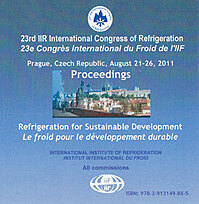
Document IIF
Analyse théorique des systèmes d'accumulation de froid dans une installation frigorifique au CO2 transcritique / sous-critique de supermarché.
Theoretical analysis of cold storage devices in a CO2 transcritical/subcritical supermarket refrigeration plant.
Numéro : pap. ID: 353
Auteurs : FERRANDI C., ORLANDI M.
Résumé
This paper proposes a theoretical study of a cold storage system in a carbon dioxide (CO2) medium temperature (MT) plant for supermarkets application. The aim of this plant strategy is that in the daily hours the storage can export heat form the refrigerant outcoming the gas cooler/condenser whereas during the nightly hours it can be maintained cooled by this latter before its incoming into the evaporator. Besides, the storage can be used for reducing the energy peak consumption, permitting to size the plant on a lower energy target, and it can influence the choice of the optimisation logic of the plant controller. In this work a model for a MT CO2 transcritical/subcritical cycle, able to manage the transient due to the changes of loads and external conditions, is proposed to take into account the evolution with time in a fixed time step. A parametrical analysis has been conduced for understanding the optimal design of the plant. A seasonal analysis is considered too, for understanding the cold storage benefits in different periods of year.
Documents disponibles
Format PDF
Pages : 8 p.
Disponible
Prix public
20 €
Prix membre*
Gratuit
* meilleur tarif applicable selon le type d'adhésion (voir le détail des avantages des adhésions individuelles et collectives)
Détails
- Titre original : Theoretical analysis of cold storage devices in a CO2 transcritical/subcritical supermarket refrigeration plant.
- Identifiant de la fiche : 30002721
- Langues : Anglais
- Source : Proceedings of the 23rd IIR International Congress of Refrigeration: Prague, Czech Republic, August 21-26, 2011. Overarching theme: Refrigeration for Sustainable Development.
- Date d'édition : 21/08/2011
Liens
Voir d'autres communications du même compte rendu (569)
Voir le compte rendu de la conférence
Indexation
-
Thèmes :
CO2;
Stockage d'énergie thermique;
Supermarchés, meubles de vente - Mots-clés : Supermarché; Stockage d'énergie; Modélisation; Cycle transcritique; Frigorigène; CO2
-
Experimental investigation on the integration o...
- Auteurs : MANESCU R. I., ALLOUCHE Y., LARRAÑAGA JANEIRO A., et al.
- Date : 24/08/2019
- Langues : Anglais
- Source : Proceedings of the 25th IIR International Congress of Refrigeration: Montréal , Canada, August 24-30, 2019.
- Formats : PDF
Voir la fiche
-
Review of supermarket refrigeration and heat re...
- Auteurs : KARAMPOUR M., SAWALHA S., ABDI A., et al.
- Date : 16/04/2015
- Langues : Anglais
- Source : 6th Conference on Ammonia and CO2 Refrigeration Technology. Proceedings: Ohrid, North Macedonia, April 16-18, 2015.
- Formats : PDF
Voir la fiche
-
Experimental evaluation of ice storage inside a...
- Auteurs : MANESCU R. I., ALLOUCHE Y., HAFNER A.
- Date : 11/04/2019
- Langues : Anglais
- Source : 8th Conference on Ammonia and CO2 Refrigeration Technology. Proceedings: Ohrid, North Macedonia, Avril 11-13, 2019.
- Formats : PDF
Voir la fiche
-
Demand side management of a commercial refriger...
- Auteurs : COCCIA G., ARTECONI A., D'AGARO P., et al.
- Date : 24/08/2019
- Langues : Anglais
- Source : Proceedings of the 25th IIR International Congress of Refrigeration: Montréal , Canada, August 24-30, 2019.
- Formats : PDF
Voir la fiche
-
Low temperature heat storages in CO2 supermarke...
- Auteurs : FIDORRA N., HAFNER A., MINETTO S., et al.
- Date : 16/08/2015
- Langues : Anglais
- Source : Proceedings of the 24th IIR International Congress of Refrigeration: Yokohama, Japan, August 16-22, 2015.
- Formats : PDF
Voir la fiche
